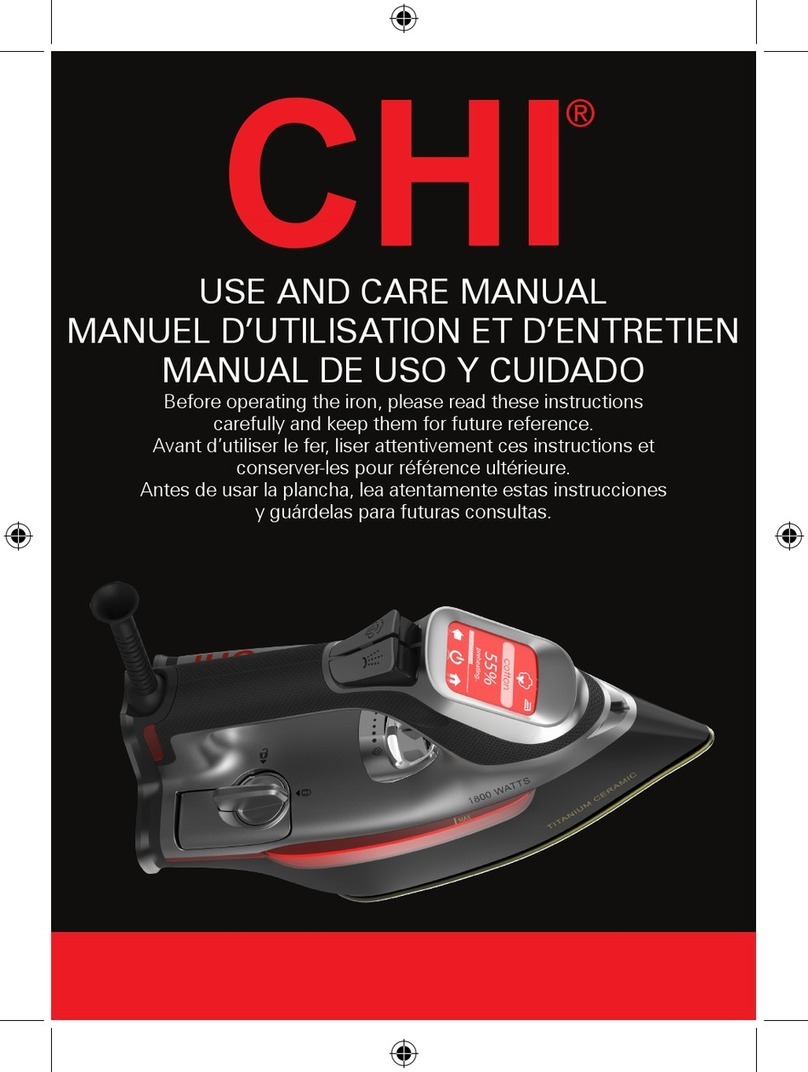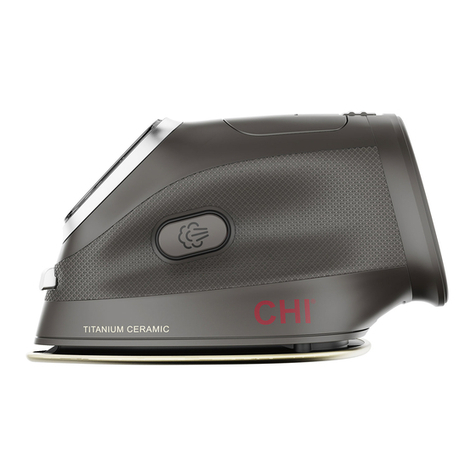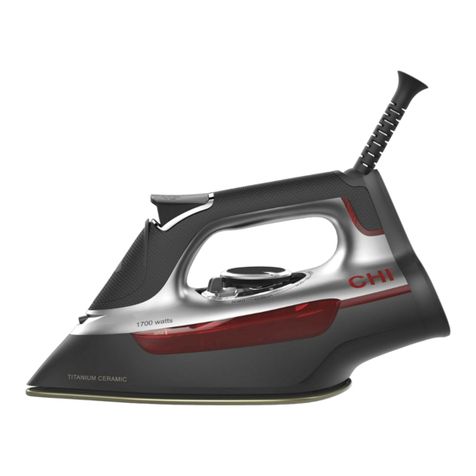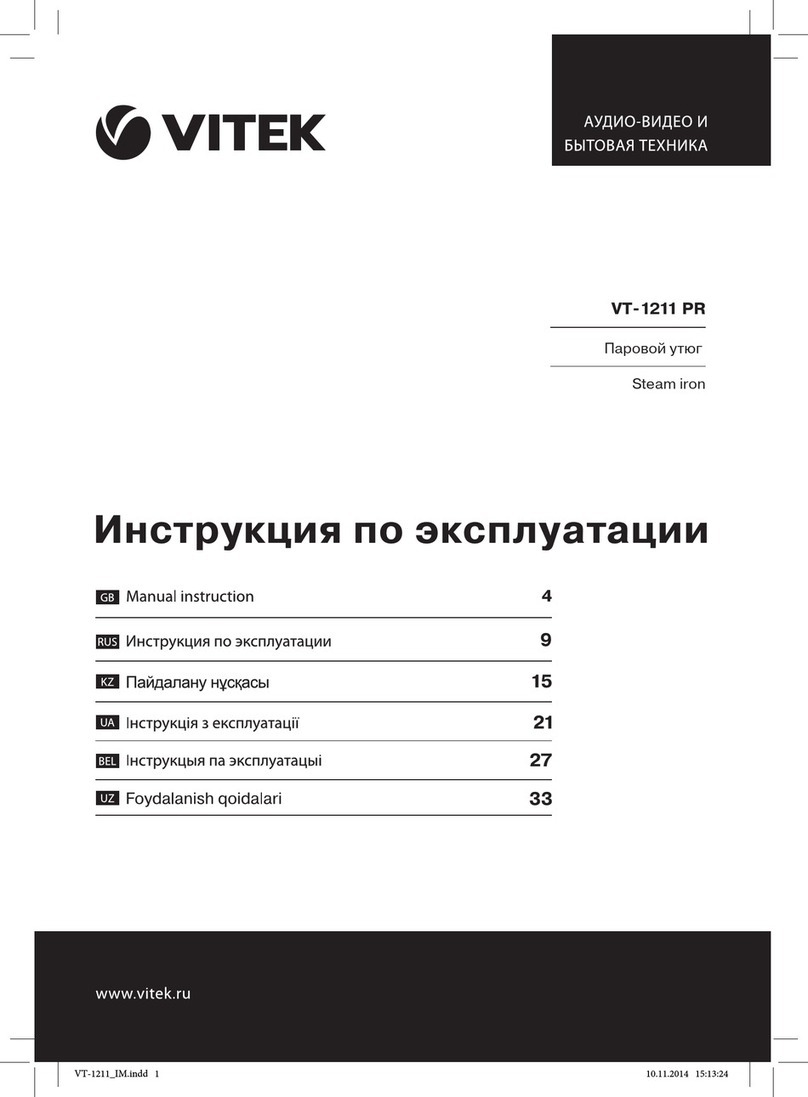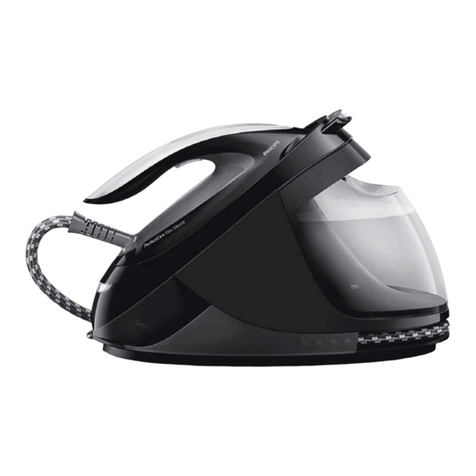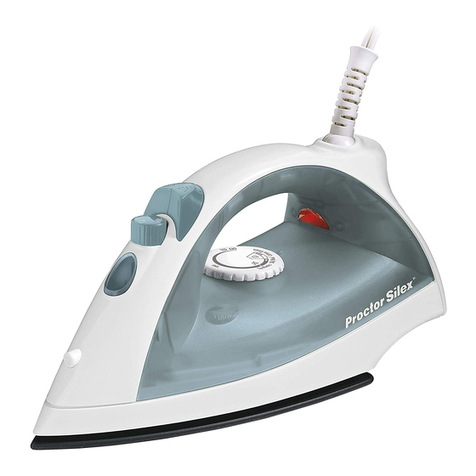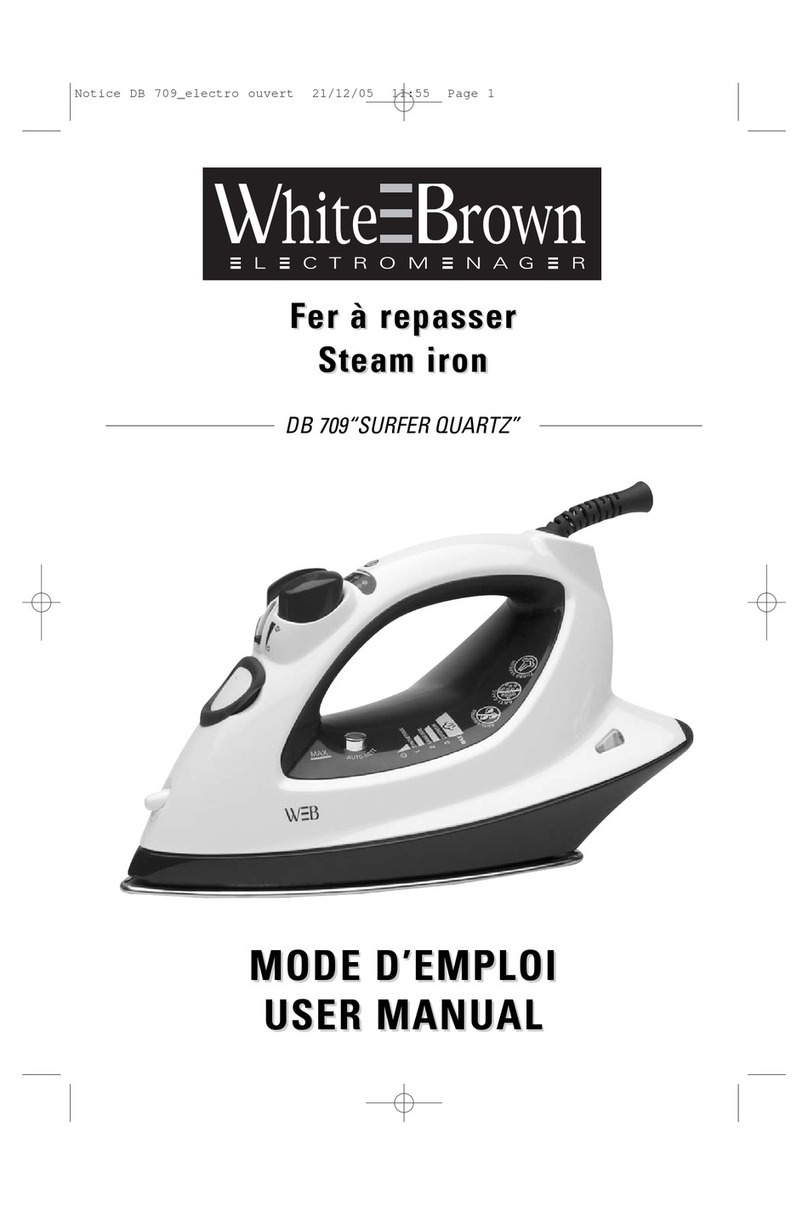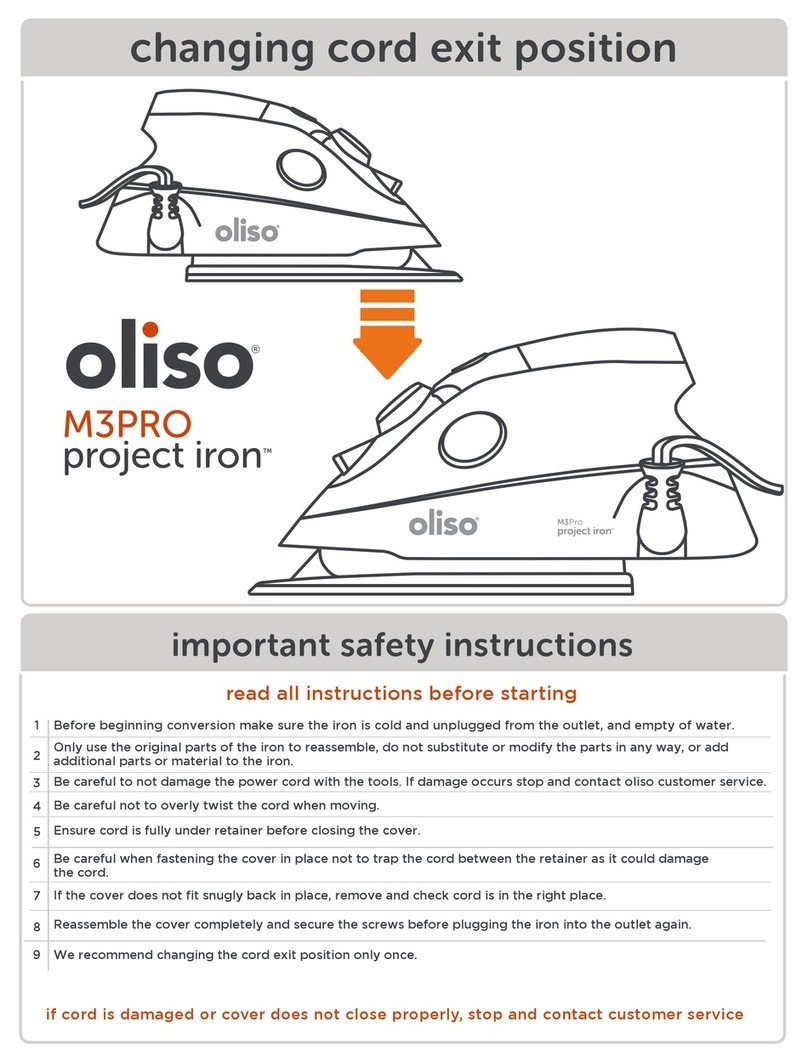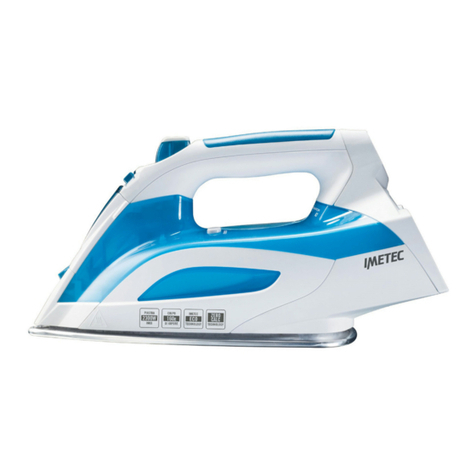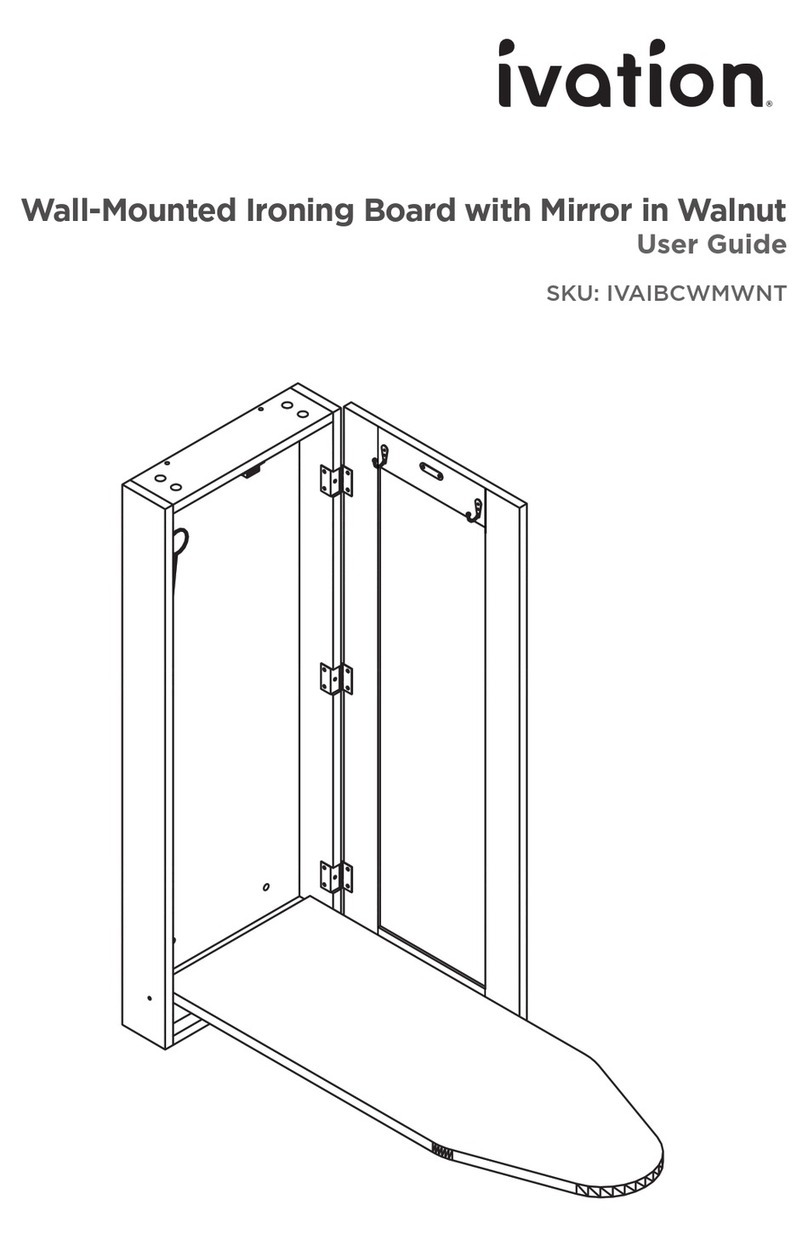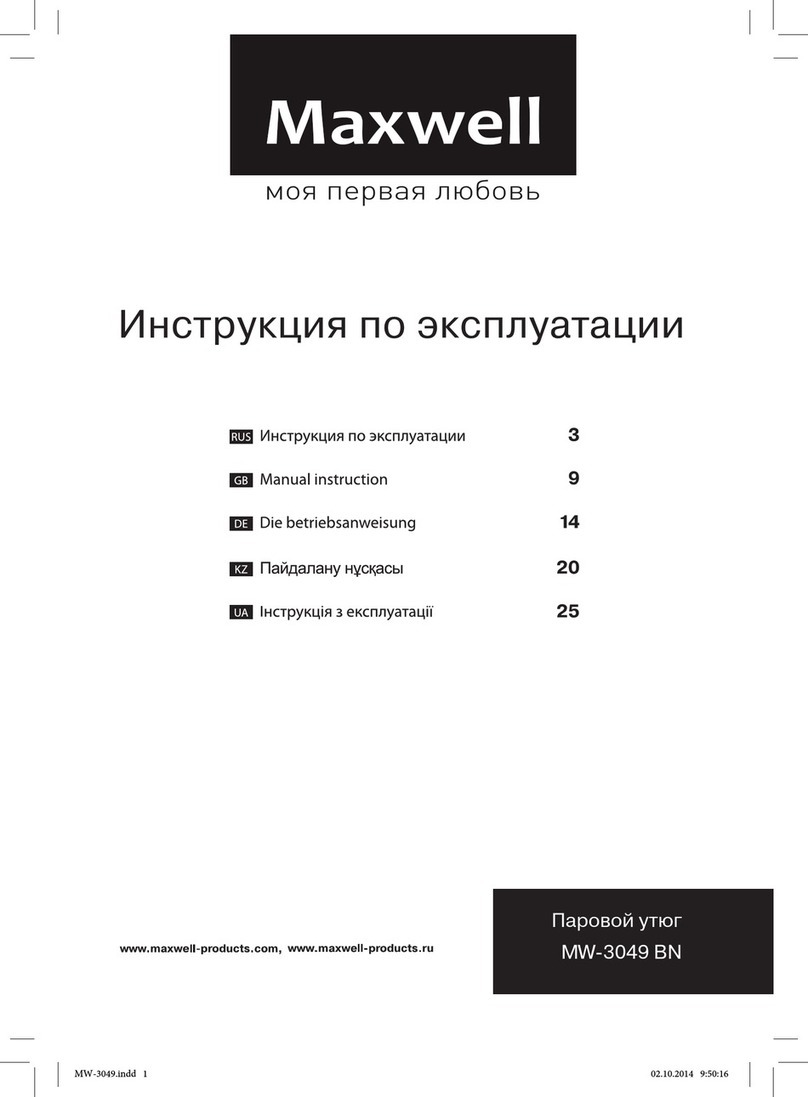CHI 13108 User manual

1
USE AND CARE MANUAL
MANUEL D’UTILISATION ET D’ENTRETIEN
MANUAL DE USO Y CUIDADO
Before operating the iron, please read these instructions
carefully and keep them for future reference.
Avant d’utiliser le fer, liser attentivement ces instructions et
conserver-les pour référence ultérieure.
Antes de usar la plancha, lea atentamente estas instrucciones
y guárdelas para futuras consultas.

2
IMPORTANT SAFEGUARDS
When using electrical appliances, basic safety precautions
should always be followed to reduce the risk of fire, electric
shock, and/or injury to persons, including the following:
1. Read all instructions.
2. This appliance is not intended for use by persons
(including children) with reduced physical, sensory, or
mental capabilities, or lack of experience and knowledge,
unless they are closely supervised and instructed
concerning use of the appliance by a person responsible
for their safety.
3. Close supervision is necessary when any appliance is
used by or near children. Children should be supervised to
ensure that they do not play with the appliance.
4. Use appliance only for its intended use.
5. To avoid the risk of electric shock, do not immerse the iron
in water or other liquids.
6. Always turn the iron to OFF ( ) before plugging or
unplugging the iron from the electrical outlet. To unplug,
grasp the plug and pull from the outlet. Never pull from the
power cord.
7. Do not let the cord touch hot surfaces. Let the iron cool
completely before putting the iron away. Coil the cord
loosely around the iron when storing.
8. Always disconnect the iron from the electrical outlet before
filling the iron with water, emptying the water from the
iron, and when the iron is not in use.
9. Always close the filling aperture when operating the
appliance.

3
10. Do not operate the iron with a damaged cord or in the
event the iron has been dropped or damaged or there
are visible signs of damage or it is leaking. To avoid the
risk of electric shock, do not disassemble the iron. Supply
cord replacement and iron repairs must be conducted
by a qualified serviceman or the manufacturer. Incorrect
assembly might result in a risk of electric shock when the
iron is used after reassembly.
11. The iron must be used and rested on a stable surface.
12. When placing the iron on its stand, ensure that the surface
on which the stand is placed is stable.
13. Do not leave the iron unattended while the iron is
connected or on an ironing board.
14. Burns can occur from touching hot metal parts, hot water,
or steam. Use caution when you turn a steam iron upside
down—there might be hot water in the reservoir.
15. To avoid a circuit overload, do not operate an iron on the
same circuit with another high-wattage appliance.
16. If an extension cord is absolutely necessary, a cord with
an ampere rating equal to or greater than the maximum
rating of the iron shall be used. A cord rated for less
amperage can result in a risk of fire or electric shock due to
overheating. Care shall be taken to arrange the cord so that
it cannot be pulled or be tripped over.
SAVE THESE INSTRUCTIONS

4
Other Consumer Safety Information
This appliance is intended for household use only.
Direct steam at clothing only. Directing steam toward any
other surface may damage that surface.
• Do not steam clothes that are being worn.
• Do not use the steam in the direction of people or pets.
wWARNING Electrical Shock Hazard: This appliance is
provided with a polarized plug (one wide blade) to reduce
the risk of electric shock. The plug fits only one way into a
polarized outlet. Do not defeat the safety purpose of the plug
by modifying the plug in any way or by using an adapter. If the
plug does not fit fully into the outlet, reverse the plug. If it still
does not fit, have an electrician replace the outlet.
To avoid an electrical circuit overload, do not use another high-
wattage appliance on the same circuit with this appliance.

5
Parts and Features
Control Panel
1. Spray Nozzle
2. Water Fill Door
3. Spray Button
4. Power/Ready Light
5. Handle
6. Heel Rest
7. Water Window
8. MAX Fill Line
9. Steam Control Levels
10. Temperature Setting Dial
11. Steam Shot Lever
12. Titanium Ceramic
Soleplate
13. Steam Shot

6
1. To Steam Iron: Make sure iron
is unplugged and the steam shot
lever is at (Dry Iron) position.
Lift Water Fill Door and add
untreated tap water to the MAX
Fill Line through the opening. If
you have extremely hard water,
mix 50% untreated tap water with
50% distilled or demineralized
water for use in the iron. Press to
snap cover closed. Plug into outlet. The red Power/Ready
Indicator Light will flash. Turn Temperature Setting Dial to
select temperature setting; linen/cotton, or wool should
be used for steaming. When temperature is reached, the
light stops flashing. The Steam
Shot Lever can now be moved
to (Steam Iron) position and is
ready to steam.
2. To Dry Iron: Plug into outlet.
The red Power/Ready Indicator
Light will flash. Turn Temperature
Setting Dial to select temperature
setting. When the temperature is
reached, the light stops flashing.
Move the Steam Shot Lever to
(Dry Iron) position and you are ready to iron.
3. To turn iron off: Move Steam Shot Lever to (Dry Iron)
and turn Temperature Setting Dial to min. Unplug.
How to Dry and Steam Iron
wCAUTION Burn Hazard. Attempting to steam iron on
a lower temperature setting or failing to allow the iron to
preheat for 2 minutes can result in hot water dripping from
the soleplate.

7
1. To Steam: Make sure iron
is unplugged and the Steam
Shot Lever is at (Dry Iron)
position. Lift Wate
r Fill Door
and add untreated tap water
to the MAX Fill Line through
the opening. If you have
extremely hard water, mix
50% untreated tap water with
50% distilled or demineralized
water for use in the iron.
Press to snap cover closed. Plug into outlet. The red
Power/Ready Indicator Light will flash. Turn Temperature
Setting Dial to the linen/cotton setting. Only the maximum
setting should be used with the Steam Shot. When the
temperature is reached, the light will stop flashing. The
Steam Shot Lever can now be moved to the (Steam
Shot) position and it is ready to steam.
How to Use Steam Shot
wCAUTION Burn Hazard. Steam is hot. Avoid contact with
escaping steam.
NOTES:
• To avoid garment damage, check garment label before
using Steamer. The label inside the clothing should
recommend fabric care instructions.
• Steaming garments will give a relaxed, not pressed, look.
• Do not use Steamer if garment label has this symbol ( ).

8
Steam
Setting Temperature
Setting Ironing Instructions
Dry Iron
MIN MIN
Synthetics
•
Low Dry iron using spray if
necessary.
Silk ••
Medium
Iron silk on wrong side.
Steam
Range
Wool
Between
Low and
Medium
Iron wool on wrong
side.
Cotton,
Linen •••
High
For cotton, iron while
still damp or use spray.
For linen, iron fabric on
wrong side.
PREPARE TO IRON
NOTE: To avoid garment damage, check garment label for
fabric composition and ironing instructions.
2. Steam garment or fabric in a location that is not
susceptible to damage from heat or moisture. Do not
hang in front of wallpaper, a window, or a mirror. Slowly
move iron vertically from top to bottom of garment.
wCAUTION Burn Hazard. Steam is hot. Always point
nozzle away from yourself and others. Never steam
clothes while they are being worn.
3. When finished steaming, move Steam Shot Lever to
(Dry Iron) position and wait until steam stops.
4. Turn Temperature Setting Dial to min. Unplug.
5. Empty water from iron. See “Care and Cleaning” section.
How to Use Steam Shot (continued)

9
FABRIC FACTS AND LABELS:
Every fabric is different and should be treated accordingly. The
label inside clothing or linens should recommend fabric care
instructions that include ironing treatment. As a general rule,
these instructions should be followed. If the fabric is a blend,
use a low temperature setting. If you do not know what the
content of the fabric is, use the lowest temperature first and
test on an inside seam.
PREPARE TO IRON:
1. Cover your ironing board with a padded, heat-resistant
cover. Brush or wipe off any dust, dirt, or debris so it
doesn’t transfer to clothing.
2. To set the height of the ironing board, stand with your
elbows bent at right angles; then drop your hands slightly
so that your arms are in a comfortable position. Set the
height of your ironing board to this height.
3. Check the soleplate for mineral deposits or scorched
material before you begin ironing. Follow “Soleplate Care”
instructions.
Tips for Best Ironing Results

10
Tips for Best Ironing Results (cont.)
FAST FACTS:
• Always iron with a lengthwise motion. Ironing in a circular
motion may stretch fabric.
• Natural fibers such as cotton and linen should be ironed
slightly damp for faster, easier ironing. If they are completely
dry, use maximum steam while ironing or mist them with
water prior to ironing.
• Any portion of a garment that has two layers of fabric such
as pockets, seams, collars, and cuffs should be ironed inside
out first.
• To press a collar, iron from the points in using small strokes
of the iron. After wrinkles are removed, crease the collar into
place by hand. Treat French cuffs similarly, gently creasing
by hand after ironing.
IRONING VERSUS PRESSING:
• You may have heard the terms “ironing” and “pressing”
used interchangeably, but they are actually quite different.
When ironing, you slide the iron back and forth over fabric.
When pressing, the iron is placed and held on the fabric
in one spot, lifted up, and this process is repeated until
the areas that need attention are smooth. A “pressing”
technique is helpful to avoid stretching fabrics.
• A pressing cloth can help reduce unwanted “shine” on
fabrics. You can purchase a pressing cloth in the laundry
care section, or a clean white dish towel or 100% cotton
pillowcase works equally well. You do not need to increase
the recommended iron temperature when using a pressing
cloth.

11
Steamer Tips
• To avoid garment damage, check garment label for fabric
content and any steaming instructions.
• Hang garments on a plastic hanger for easier steaming.
Wooden hangers will get damaged if used for steaming
clothes.
• Allow steamed garment to cool and dry before wearing or
storing in a closet.
• For more difficult wrinkles, try steaming from underside of
fabric. This allows fibers in fabric to relax.
• Pants are more easily steamed upside down, with pants
hanging from cuffs.

12
1. Unplug. Allow iron to cool.
2. To empty water from iron, lift Water Fill Door and slowly tilt
pointed end of iron over a sink until all the water has poured
out.
3. Store iron on the Heel Rest. Allow iron to cool before
storing.
Care and Cleaning
Soleplate Care
To clean an iron’s soleplate, preheat the iron to the linen (
•••
)
setting and iron over a damp, 100% cotton cloth. This creates
heavy steam that transfers residue from the soleplate to the
cloth.
NOTES:
• Care should be used while cleaning; steam can burn.
• Never iron over zippers, pins, metal rivets, or snaps since
these may scratch the soleplate.
• Do not use abrasive cleansers or metal scouring pads.
• Do not use chemical cleaners or hot cleaners, as this will
damage the soleplate finish.

13
Iron won’t heat.
• Plug iron into a working outlet.
• Select a temperature.
Water is leaking.
• Too much water is in the water tank.
• Make sure temperature dial is set in the steam zone (wool,
linen/cotton).
• Wait until Power/Ready Indicator Light stops flashing,
indicating that selected temperature in the steam zone has
been reached. Then, move Steam Shot Lever to (Steam
Iron).
• If dry ironing, make sure the Steam Shot Lever is in the
(Dry Iron) position.
Iron won’t steam.
• Ensure there is water in the water tank.
• Make sure temperature dial is set in the steam zone (wool,
linen/cotton).
• Wait until Power/Ready Indicator Light stops flashing,
indicating that selected temperature in the steam zone has
been reached. Then, move Steam Shot Lever to (Steam
Iron).
• Move the Steam Shot Lever to the (Steam Iron) position.
Water spitting from Steam Shot.
• Ensure Temperature Setting Dial is set to linen/cotton
(•••)
.
• Minor water spitting is normal during the start of steaming.
Troubleshooting

14
Limited Warranty
This warranty applies to products purchased and used in the U.S. and
Canada. This is the only express warranty for this product and is in lieu of
any other warranty or condition.
This product is warranted to be free from defects in material and
workmanship for a period of two (2) years from the date of original
purchase. During this period, your exclusive remedy is repair or
replacement of this product or any component found to be defective, at
our option; however, you are responsible for all costs associated with
returning the product to us and our returning a product or component
under this warranty to you. If the product or component is no longer
available, we will replace with a similar one of equal or greater value.
This warranty does not cover glass, filters, wear from normal use, use
not in conformity with the printed directions, or damage to the product
resulting from accident, alteration, abuse, or misuse. This warranty
extends only to the original consumer purchaser or gift recipient. Keep the
original sales receipt, as proof of purchase is required to make a warranty
claim. This warranty is void if the product is used for other than single-
family household use or subjected to any voltage and waveform other
than as specified on the rating label (e.g., 120 V ~ 60 Hz).
We exclude all claims for special, incidental, and consequential damages
caused by breach of express or implied warranty. All liability is limited
to the amount of the purchase price. Every implied warranty, including
any statutory warranty or condition of merchantability or fitness for
a particular purpose, is disclaimed except to the extent prohibited
by law, in which case such warranty or condition is limited to the
duration of this written warranty. This warranty gives you specific legal
rights. You may have other legal rights that vary depending on where
you live. Some states or provinces do not allow limitations on implied
warranties or special, incidental, or consequential damages, so the
foregoing limitations may not apply to you.
To make a warranty claim, do not return this appliance to the store. Please
call CHI Garment Care 1.844.882.9038 in the U.S. or visit www.chisteam.com
in the U.S. For faster service, locate the model, type, and series numbers on
your appliance.

15
PRÉCAUTIONS IMPORTANTES
Pour utiliser un appareil électroménager, vous devez toujours
prendre des mesures élémentaires de sécurité pour réduire le
risque d’incendie, d’électrocution et/ou de blessure corporelle,
en particulier les mesures suivantes :
1. Lire toutes les instructions.
2. Cet appareil n’est pas destiné à être utilisé par des
personnes (y compris les enfants) dont les capacités
physiques, sensorielles ou mentales sont réduites, ou
manquant d’expérience et de connaissance, sauf si elles
sont étroitement surveillées et instruites sur l’utilisation
de l’appareil par une personne responsable de leur
sécurité.
3. Une surveillance étroite est requise pour tout appareil
utilisé par ou près des enfants. Surveiller que les enfants
ne jouent pas avec l’appareil.
4. Utiliser exclusivement le fer pour son usage prévu.
5. Pour éviter le risque de choc électrique, ne pas plonger le
fer dans l’eau ou d’autres liquides.
6. Le fer doit toujours être éteint (réglé à OFF/ ) avant d’être
branché à une prise de courant ou débranché. Pour
débrancher, saisir la fiche et la retirer de la prise. Ne pas
tirer sur le cordon d’alimentation.
7. Ne pas laisser le cordon toucher les surfaces chaudes.
Laisser refroidir le fer complètement avant de le remiser.
Enrouler lâchement le cordon autour du fer à repasser
pour ranger.
8. Toujours débrancher le fer d’une prise de courant
électrique lorsqu’on le remplit d’eau ou lorsqu’on le vide,
ou si l’appareil n’est pas utilisé.
9. Veuillez toujours fermer l’ouverture pour le remplissage
lors de l’utilisation de l’appareil.

16
10. Ne pas utiliser le fer avec un cordon endommagé, si le
fer est tombé ou endommagé, s’il y a des signes visibles
de dommage ou s’il fuit. Pour éviter le risque de choc
électrique, ne pas démonter le fer. Le faire examiner
et réparer par un dépanneur qualifié. Un assemblage
incorrect risque d’entraîner un risque de choc électrique
lorsque le fer est utilisé après réassemblage.
11. Le fer doit être utilisé et reposé sur une surface stable.
12. En plaçant le fer sur son support, assurez-vous que la
surface sur laquelle le support est placé est stable.
13. Ne pas laisser le fer sans surveillance pendant qu’il est
branché ou pendant qu’il est sur une planche à repasser.
14. Des brûlures peuvent survenir lorsqu’on touche des
pièces chaudes en métal, de l’eau chaude ou de la vapeur.
Adopter des précautions lorsqu’on tourne un fer à vapeur
à l’envers, car il peut rester de l’eau chaude dans le
réservoir.
15. Pour éviter une surcharge du circuit, ne pas utiliser le
fer sur le même circuit qu’un autre appareil de haute
puissance.
16. Si une rallonge électrique est absolument nécessaire,
un cordon d’intensité nominale égale ou supérieure à
l’intensité nominale maximale du fer doit être utilisé. Un
cordon d’une intensité nominale moindre peut entraîner
un risque d’incendie ou de choc électrique en raison d’une
surchauffe. Il faut prendre soin de placer le cordon de
rallonge pour qu’il ne puisse pas être tiré par des enfants
ou faire trébucher.
CONSERVER CES INSTRUCTIONS

17
Autres consignes de sécurité pour le
consommateur
Cet appareil est destiné à un usage domestique uniquement.
Diriger uniquement la vapeur vers les vêtements. Éviter de
diriger la vapeur vers toutes autres surfaces pour ne pas
endommager celles-ci.
• Ne passer pas à la vapeur des vêtements que vouz portez.
• Ne projeter pas la vapeur sur les gens ou sur les animaux.
wAVERTISSEMENT Risque de choc électrique : Cet appareil
est fourni avec une fiche polarisée (une broche large) pour
réduire le risque d’électrocution. Cette fiche n’entre que dans
un seul sens dans une prise polarisée. Ne contrecarrez pas
l’objectif sécuritaire de cette fiche en la modifiant de quelque
manière que ce soit ou en utilisant un adaptateur. Si vous
ne pouvez pas insérer complètement la fiche dans la prise,
inversez la fiche. Si elle refuse toujours de s’insérer, faire
remplacer la prise par un électricien.
Pour éviter la surcharge du circuit électrique, ne pas utiliser un
autre appareil à haute puissance sur le même circuit que cet
appareil.

18
Pièces et caractéristiques
1. Bouton de vapeur
2. Porte de remplissage
d’eau
3. Bouton de vaporisation
4. Indicateur lumineux/
d’alimentation
5. Poignée
6. Talon d’appui
7. Niveau d’eau
8. Ligne de remplissage
MAX
9. Niveaux de réglage de la
vapeur
10. Cadran de réglage des
températures
11. Levier du jet de vapeur
12. Semelle en céramique de
titane
13. Jet de vapeur
Panneau de contrôle

19
1. Repassage à la vapeur : Assurez-
vous que le fer est débranché et que le
levier du jet de vapeur est à la position
(repassage à sec). Soulever le
couvercle pour le remplissage d’eau et
ajouter de l’eau du robinet non traitée
jusqu’à la ligne de remplissage MAX
à travers l’ouverture. Si vous avez
de l’eau extrêmement dure, faire un
mélange de 50 % d’eau du robinet non
traitée et de 50 % d’eau distillée pour utiliser dans le fer. Appuyer
pour fermer le couvercle. Brancher dans une prise de courant et le
voyant d’alimentation rouge s’allume. Tourner le cadran de réglage des
temperatures pour choisir le réglage de temperature. Le lin, le coton ou
la laine devrait être utilisé pour la vapeur. Lorsque la température est
atteinte, le voyant arrête de clignoter. Le levier du jet de vapeur peut
être déplacé à la position (repassage à la vapeur), et le fer est prêt
à dégager de la vapeur.
2. Repassage à sec : Brancher dans une
prise de courant. L’indicateur lumineux/
d’alimentation rouge clignotera. Tourner
le cadran de réglage de température
afin de sélectionner le réglage de la
température. Lorsque la température est
atteinte, le voyant arrête de clignoter.
Déplacer le levier du jet de vapeur à la
position (repassage à sec), et le fer
est prêt pour le repassage.
3. Pour éteindre le fer : Déplacer le levier du jet de vapeur à la position
(repassage à sec) et tourner le cadran de réglage de température
à min. Débrancher.
Repassage à sec et à la vapeur
wATTENTION Risque de brûlures. La tentative du repassage
à la vapeur à un réglage de température inférieur ou ne pas
laisser le fer chauffer pendant 2 minutes peut occasionner
un égouttement d’eau depuis la semelle.

20
1. Repasser à la vapeur : Veuillez
vous assurer que le fer est
débranché et que le levier du jet
de vapeur est à la position
(repassage à sec). Soulever le
couvercle pour le remplissage
d’eau et ajouter de l’eau du
robinet non traitée jusqu’à la ligne
de remplissage MAX à travers
l’ouverture. Si vous avez de l’eau
extrêmement dure, faire un mélange
de 50 % d’eau du robinet non traitée et de 50 % d’eau distillée pour
utiliser dans le fer. Appuyer pour enclencher le couvercle. Brancher
dans la prise. L’indicateur d’alimentation rouge clignotera. Tourner
le cadran de réglage de température lin/coton. Le jet de vapeur ne
doit être utilisé qu’avec le réglage maximum. Lorsque la température
est atteinte, le voyant arrête de clignoter. Le levier du jet de vapeur
peut être déplacé à la position (jet de vapeur), et le fer est prêt à
dégager de la vapeur.
Comment utiliser le jet de vapeur
wATTENTION
Risque de brûleres. La vapeur est chaude. Éviter le
contact avec l’échappement de la vapeur.
REMARQUES :
• Pour éviter d’endommager le vêtement, vérifier l’étiquette du vêtement
avant d’utiliser la machine à vapeur portative. L’étiquette à l’intérieur des
vêtements indique les instructions d’entretien recommandées du tissu.
• Le défroissage donnera une apparence décontractée, non pressée, aux
vêtements.
• Ne pas utiliser cette machine à vapeur portative si l’étiquette du
vêtement indique ce symbole ( ).
This manual suits for next models
1
Table of contents
Languages:
Other CHI Iron manuals
